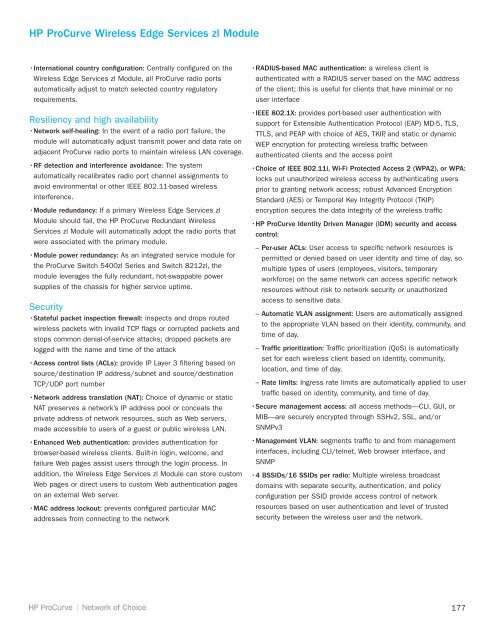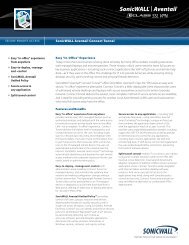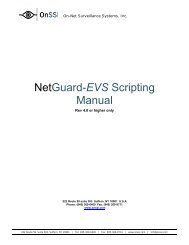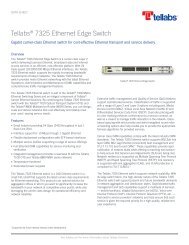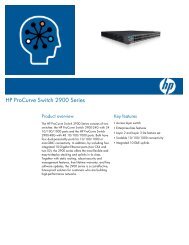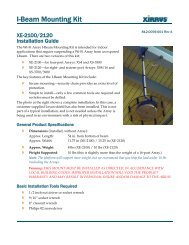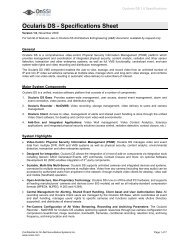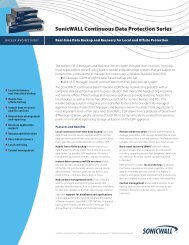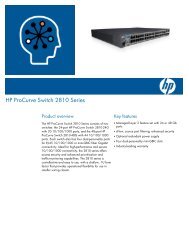HP ProCurve Networking Datasheets - Moonblink
HP ProCurve Networking Datasheets - Moonblink
HP ProCurve Networking Datasheets - Moonblink
Create successful ePaper yourself
Turn your PDF publications into a flip-book with our unique Google optimized e-Paper software.
<strong>HP</strong> <strong>ProCurve</strong> Wireless Edge Services zl Module<br />
• International country configuration: Centrally configured on the<br />
Wireless Edge Services zl Module, all <strong>ProCurve</strong> radio ports<br />
automatically adjust to match selected country regulatory<br />
requirements.<br />
Resiliency and high availability<br />
• Network self-healing: In the event of a radio port failure, the<br />
module will automatically adjust transmit power and data rate on<br />
adjacent <strong>ProCurve</strong> radio ports to maintain wireless LAN coverage.<br />
• RF detection and interference avoidance: The system<br />
automatically recalibrates radio port channel assignments to<br />
avoid environmental or other IEEE 802.11-based wireless<br />
interference.<br />
• Module redundancy: If a primary Wireless Edge Services zl<br />
Module should fail, the <strong>HP</strong> <strong>ProCurve</strong> Redundant Wireless<br />
Services zl Module will automatically adopt the radio ports that<br />
were associated with the primary module.<br />
• Module power redundancy: As an integrated service module for<br />
the <strong>ProCurve</strong> Switch 5400zl Series and Switch 8212zl, the<br />
module leverages the fully redundant, hot-swappable power<br />
supplies of the chassis for higher service uptime.<br />
Security<br />
• Stateful packet inspection firewall: inspects and drops routed<br />
wireless packets with invalid TCP flags or corrupted packets and<br />
stops common denial-of-service attacks; dropped packets are<br />
logged with the name and time of the attack<br />
• Access control lists (ACLs): provide IP Layer 3 filtering based on<br />
source/destination IP address/subnet and source/destination<br />
TCP/UDP port number<br />
• Network address translation (NAT): Choice of dynamic or static<br />
NAT preserves a network’s IP address pool or conceals the<br />
private address of network resources, such as Web servers,<br />
made accessible to users of a guest or public wireless LAN.<br />
• Enhanced Web authentication: provides authentication for<br />
browser-based wireless clients. Built-in login, welcome, and<br />
failure Web pages assist users through the login process. In<br />
addition, the Wireless Edge Services zl Module can store custom<br />
Web pages or direct users to custom Web authentication pages<br />
on an external Web server.<br />
• MAC address lockout: prevents configured particular MAC<br />
addresses from connecting to the network<br />
• RADIUS-based MAC authentication: a wireless client is<br />
authenticated with a RADIUS server based on the MAC address<br />
of the client; this is useful for clients that have minimal or no<br />
user interface<br />
• IEEE 802.1X: provides port-based user authentication with<br />
support for Extensible Authentication Protocol (EAP) MD-5, TLS,<br />
TTLS, and PEAP with choice of AES, TKIP, and static or dynamic<br />
WEP encryption for protecting wireless traffic between<br />
authenticated clients and the access point<br />
• Choice of IEEE 802.11i, Wi-Fi Protected Access 2 (WPA2), or WPA:<br />
locks out unauthorized wireless access by authenticating users<br />
prior to granting network access; robust Advanced Encryption<br />
Standard (AES) or Temporal Key Integrity Protocol (TKIP)<br />
encryption secures the data integrity of the wireless traffic<br />
• <strong>HP</strong> <strong>ProCurve</strong> Identity Driven Manager (IDM) security and access<br />
control:<br />
– Per-user ACLs: User access to specific network resources is<br />
permitted or denied based on user identity and time of day, so<br />
multiple types of users (employees, visitors, temporary<br />
workforce) on the same network can access specific network<br />
resources without risk to network security or unauthorized<br />
access to sensitive data.<br />
– Automatic VLAN assignment: Users are automatically assigned<br />
to the appropriate VLAN based on their identity, community, and<br />
time of day.<br />
– Traffic prioritization: Traffic prioritization (QoS) is automatically<br />
set for each wireless client based on identity, community,<br />
location, and time of day.<br />
– Rate limits: Ingress rate limits are automatically applied to user<br />
traffic based on identity, community, and time of day.<br />
• Secure management access: all access methods—CLI, GUI, or<br />
MIB—are securely encrypted through SSHv2, SSL, and/or<br />
SNMPv3<br />
• Management VLAN: segments traffic to and from management<br />
interfaces, including CLI/telnet, Web browser interface, and<br />
SNMP<br />
• 4 BSSIDs/16 SSIDs per radio: Multiple wireless broadcast<br />
domains with separate security, authentication, and policy<br />
configuration per SSID provide access control of network<br />
resources based on user authentication and level of trusted<br />
security between the wireless user and the network.<br />
177


